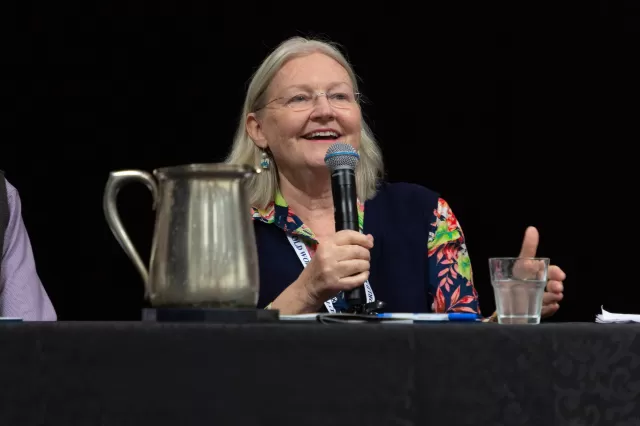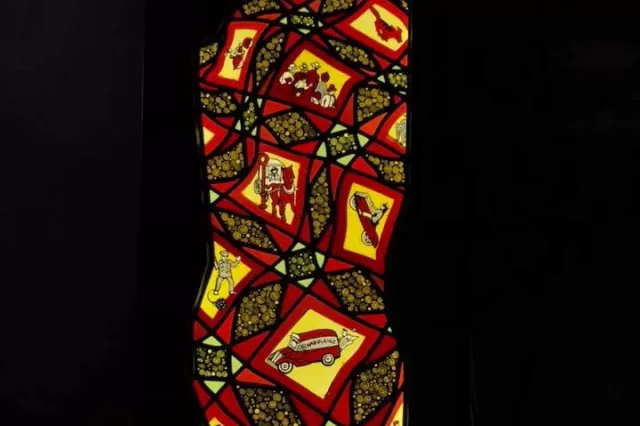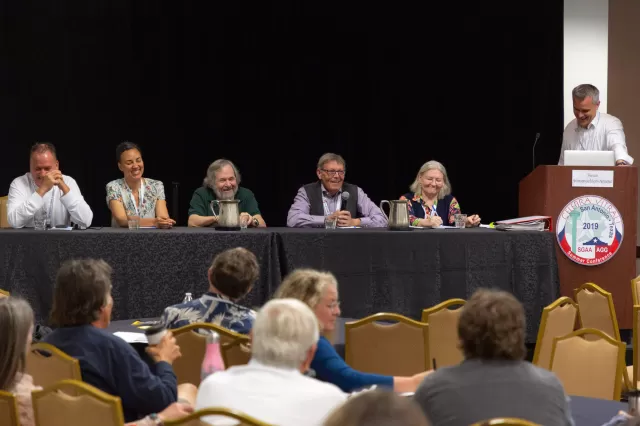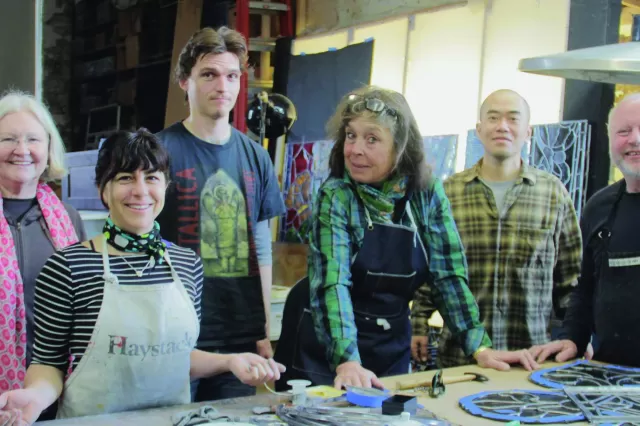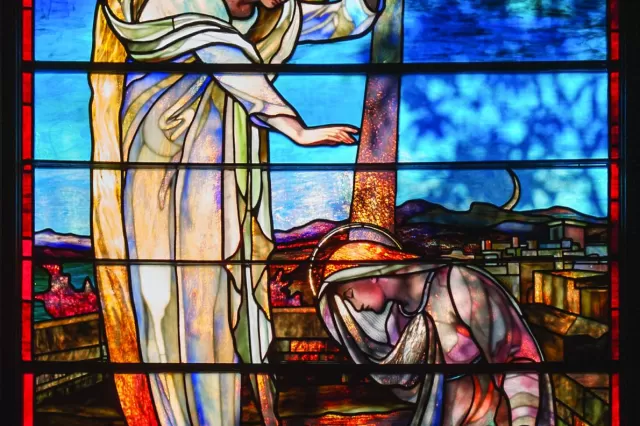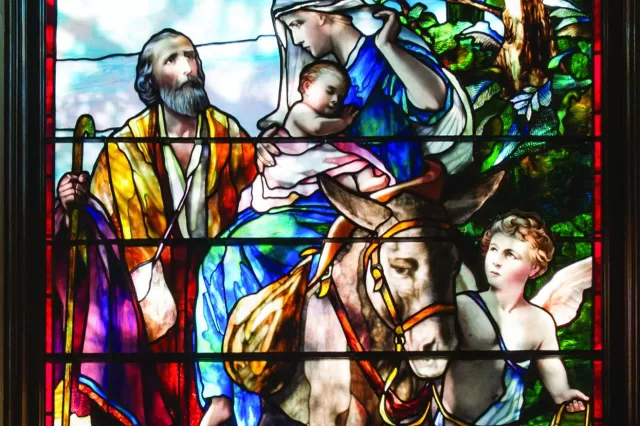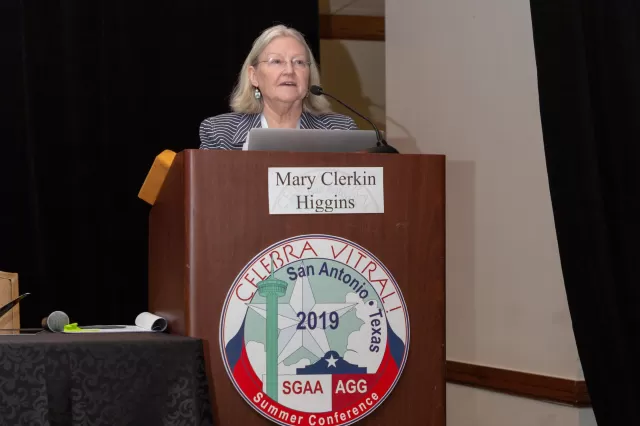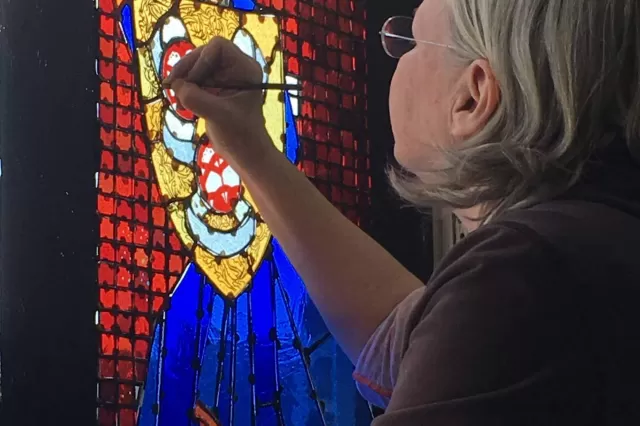At 4:30am December 25th, 2020, internationally recognized stained glass conservator and scholar Mary Clerkin Higgins passed away after a long battle with cancer.
Mary Clerkin Higgins was an award-winning artist and conservator who has worked in stained glass since 1976. She has written about, lectured internationally, and restored stained glass from the 12th century to the present for numerous museums and institutions around the country, while also creating new works of art at her
studio in Brooklyn, NY. Windows that she has built and worked on are in Cathedrals, Museums, and Universities around the world. Among the institutions that have turned to Mary for her stained glass conservation expertise are Harvard University, The Nasher Museum, the Metropolitan Museum of Art, the United Nations and many others.
Mary lived life intensely, passionately, and generously, dedicated to stained glass and to those she loved. The entire community is lucky to have her works of art and her writings to turn to in her memory. Here, we share the last piece she wrote for Stained Glass, our quarterly magazine, where she writes about the conservation of three of J&R Lamb’s Stanford Memorial Church windows on the campus of Stanford University.
PDF Download of this article at the bottom of the page
Clerkin Higgins Stained Glass recently undertook a stained glass conservation project at Stanford Memorial Church on the campus of Stanford University
Conserving J&R Lamb’s Beautiful Stanford Windows
By Mary Clerkin Higgins
The church is dedicated to Senator Leland Stanford, co-founder of Stanford University with his wife Jane Lathrop Stanford. He died in 1893 and the church was dedicated 10 years later, in 1903.
Mrs. Stanford hired the firm of J & R Lamb to make 51 stained-glass windows for the new building. Led by artist Frederick Stymetz Lamb, the work was completed in three years, which is quite remarkable. Lamb was an artist known for his stained glass, murals, and landscape paintings. He was the second generation to run the J. & R. Lamb Studio which was established by his father and uncle, Joseph and Richard Lamb, in 1857 in Greenwich Village. Frederick was its head of design and supervised the firm’s team of skilled craftsmen. The project brought Lamb to the west coast for the first time and he enjoyed the Bay area so much that in 1922 at the age of 59 he moved there, living and working in Berkeley Hills and visiting the Mendocino Coast during summers, where he died in 1928.
There are over 100 windows in the church. The 51 by Frederick Lamb are 19 large aisle and apse windows depicting the life of Christ, and 32 smaller, single figures in the balconies and clerestory. Mrs. Stanford had a clear idea of what she wanted the large windows to look like, and for years had collected images of paintings and prints with that in mind. Lamb’s job was to translate those images into stained glass windows, augmenting and altering them as necessary to fill the openings. Clerkin Higgins restored the three aisle windows in the east arcade of the nave, each 15 feet tall by 5½ feet wide: The Annunciation, The Flight into Egypt, and The Holy Family.
THE ANNUNCIATION
The Annunciation is based on an oil painting now in the Manchester Art Gallery by the British artist, illustrator, and designer Frederick James Shields, who was closely associated with the Pre-Raphaelites. In his painting the Archangel Gabriel announces to the Virgin Mary that she will give birth to Christ. Mary kneels, her head bowed as Gabriel extends his right hand toward her and points upward with his left. Shafts of wheat and a piece of bread—symbols of the Eucharist and the human
nature of Christ—lie next to Mary. Pink almond blossoms in the foreground symbolize divine approval. The background contains a town and a thin crescent moon on the horizon. Lamb was very faithful to the original, changing colors, but almost exactly reproducing the scene. To fill out the elongated opening he added beams of light emanating from a Dove above, as the Holy Spirit.
THE FLIGHT INTO EGYPT
The Flight into Egypt is based on a print by Bernard Plockhorst, a German painter and graphic artist, whose work, especially his print, The Good Shepherd, was frequently used in stained glass design. Walking in a landscape, a small angel with wings holds the donkey’s lead, guiding the way. Mary, with Jesus at her breast, gazes at Joseph, who looks back as he walks alongside. Lamb is again very faithful to the original. He has added putti in clouds above as well as lush tree branches.
THE HOME IN NAZARETH
Johann Heinrich Hofmann was a German painter of the late 19th, early 20th century best known for his many paintings depicting the life of Christ. Both he and Plockhorst were influenced by the Nazarene movement, as were the Pre-Raphaelites, with their goal to revive honest expression and spirituality in art and abandon the strictures of the academy and salon art. In “The Home in Nazareth” Mary sits with her spindle, spinning thread from the distaff on her left. Jesus carries a measure and square, which together form the shape of a cross, to Joseph, who holds an ax for shaping the thick beam before him. Three doves sit outside their birdhouse above and a hen with chicks, roosts below. Lamb has again successfully translated the print into stained glass, changing some colors, but removing extraneous details like the hen and chicks.
EARTHQUAKE
All three windows were in place by the dedication in 1903. Three years later a massive earthquake hit, severely damaging the church’s front façade and the tower above the crossing. Nine windows in the church were totally destroyed, though none of them were Lamb’s, whose windows each averaged about 10% of damage. All the stained glass was removed for restoration while the church was rebuilt. They decided not to rebuild the tower and to redesign the front façade, with a larger, differently shaped window and a smaller mosaic dedication.
PROBLEMS TO ADDRESS
In the last 100 years, the windows have been worked on as necessary. The most compelling reason to undertake this conservation treatment was the condition of the leads. Numerous cracks had developed throughout the lead network, significantly reducing its structural integrity. The individual sections are very large and heavy and most leads were cracked and weakened. Before removing the sections from the frame, it was necessary to tape them on both sides—avoiding any painted areas—to ensure the glass did not fall apart when lifted out of its frame—which is when it’s at its most vulnerable. The tape was removed when the panels arrived at the studio.
Most of the windows were two layers of glass, stacked in the leads, with three or four layers in places. Over time inaccessible dirt, dried out putty, an uneven black film of soot, and tide marks from water entering the interspace and moving the dirt around, were trapped between the layers, clouding the glass, dimming the light passing through, and making the figures look like they needed a good bath. Cleaning the window was another motivation for treatment.
Glass had broken over the years. Some breaks had been repaired, others not. Sometimes flanges covered the breaks on each side, other times glass was ground away along the break edge to make room for a repair lead. In a few places original glass had been replaced. Removing as many of these extraneous leads as possible was another goal while treating the windows.
As each section was removed from its frame it was immediately enclosed in a foam and foam core support, before it left the scaffolding. These packages went immediately into crates that were then handled by fine-art shippers for the trip to the studio in Brooklyn.
TREATMENT
The first step was to take documentation photographs of each panel: the front in transmitted light (where light passes through the glass) and both the front and back in reflected light (where light bounces off the glass). These photographs are part of the treatment report and were consulted constantly during the treatment process.
Three rubbings were taken of each section. One on archival vellum was annotated with the different types of lead, any breaks in the glass, where any additional layers were, whether they were on the front or the back of the panel, as well as the location of the copper tie wires. Two more rubbings were done for laying out the glass during the process and then releading the window.
Once removed from its leads the unpainted glass was cleaned over a light box with water and a gentle surfactant, Orvus, to remove the significant amount of dirt on the front and back surfaces of the window, as well as what was trapped in the interspace. Scalpels were used where necessary to remove old putty and paint drips. Painted glass was cleaned very gently with a mild organic, enzymatic solution and cotton swabs aided by microscopes and light boxes.
PAINTED GLASS
Very little of the glass was painted -mainly the flesh and inscriptions—and that paint was in very good condition—well fused to the glass surface. The flesh pieces were two layers, both of which were painted. The front/interior layer was white opalescent glass painted primarily with black and brown paint, as well as some colored-enamel washes. The exterior layer was clear rolled glass painted primarily with colored enamels.
One wonderful aspect of the windows at Memorial Church is that they can be easily read from the exterior of the building, which is very unusual for stained-glass. This is mainly because of the clever way the glass has been painted and layered. As light passes through the outer clear glass, which is painted with colored enamels, some of the light bounces back off the inner layer of white glass, allowing us to read the features from the outside, which adds immeasurably to the overall effect of the church. Opalescent windows by Tiffany Studios and La Farge aren’t fully readable from the exterior unless lit from inside, because there is usually white glass on the outer layer of the faces. Memorial Church does not have protective glazing on the exterior, which many opalescent windows have. With the mild California climate, the church has never needed protective glazing and for aesthetic reasons it never should have it.
GLUING GLASS
Breaks were cleaned well and glued using Hxtal NYL1 conservation epoxy, which has done very well in accelerated aging tests and has a refractive index close to that of many modern architectural glasses.
SILICONE FILLS
There were several instances where a broken piece of streaky opalescent glass had been grozed (ground) along the break edge to make room for an opaque repair lead. Epoxy fills in streaky opalescent glass are a challenge because the color changes are so frequent and dramatic within one piece of glass. Since Lamb’s aesthetic was to have large fields of color not broken up with leads, I eventually decided to try a new way to fill the gaps using colored silicone mixed in small batches to match
the varieties of color in one piece of glass, working across the break line.
Silicone fills have been done before, but an innovation that struck me as I started these fills was to use colored glass enamels as the colorants. They are essentially finely ground up glass with great color stability and they mix and bond well with silicone. Most studios have a large range of colors on hand and they are more stable than dyes—though dyes work better when matching transparent blown glasses. My goal was to match the glass color in transmitted light. The panels’ additional layers
of plating help hide the fill. Wherever the silicone fill was to be exposed to the elements it was protected with a clear exterior glass plate that had a little texture on it (i.e. not flat doublestrength glass which would be too reflective). The edges of any pieces with silicone fills were sealed and strengthened by filling the gaps between the layers with a small bead of silicone to better hold all the pieces together.
GLASS FILLS
There were a number of replacement pieces in the windows, some of which were disturbing and called for replacement. If fills were fine they were left in place. It can be extremely difficult to find appropriate replacement glass, so what I was aiming for was a more accurate match. I have a wall of old glass at my studio that I have bought from past “old timers” which is a wonderful resource for finding glass.
INPAINTING
There are almost always chips missing along a break line which must be carefully filled and then in-painted to replace both the missing glass and vitreous paint. There were instances where original paint was missing in small drips and such, and needed to be touched up. These were delicately in-painted using Artist’s Alkyd paints.
SEALING INTERSPACE
As mentioned earlier, these windows do not have protective glazing and for aesthetic reasons never should. In the past dirt, soot, and dried putty had migrated between the two layers of plates, so this time it was decided to seal the space between the two base layers using copper-foil tape wrapped around the edges of the stacked glass, to keep the interspace clean for as long as possible. The releaded window was puttied as usual.
EXTREME GLASS CUTTING
One problem Lamb had with faithfully translating a print or painting into stained glass was that some shapes found in the originals are a challenge to achieve in glass. Cutting involves making a series of scratches, or “scores,” on the glass surface to encourage it to break where you want it to. For difficult shapes you have to plan out where to stress it and deep cuts can be very difficult to make—especially without modern-day glass saws or water-jet cutters. While this took a great degree of
skill and experience, there’s a long-term danger with extreme cutting—you may be building a vulnerability into the window, leaving it one jolt away from breaking. Or not—but it’s a risk. Some shapes broke, others haven’t, yet. And while any piece of glass can break, we all know some shapes are more vulnerable than others.
RELEADING
Glazing these complex windows was extremely challenging, especially with Lamb’s penchant for fragile cuts, interlocking shapes, and large pieces of glass. The narrow bands in the top arches on all three windows have numerous hand-cut lead inlays, so it was decided to preserve the original lead work in this one place, since doing so would not affect the stability of the window. All other leads were replaced.
Frames often catch just ⅜" of a panel’s edge on each side, with an additional ⅛" for movement. The three bottom sections in all three windows were cut smaller than those above them. If glazed tightly they would be ½" smaller than the others, so they needed to be “spread” to gain the extra ½" in width. Small pieces of steel bar were inserted to build out the size without weakening the panel. The top sections were all short and needed to be built out at the top of the arch with extra lead came to reach the frame. Lead alone is malleable and easily moves out of plane, so the window was built out with clear glass covered with lead to provide structure while
reaching the necessary size.
INSTALLATION
After puttying and adding copper tie wires all the sections were photographed again before everything went into the crate for the trip out to California. The crew (Takuji Hamanaka, Marie Foucault-Phipps, Larry Gordon, and myself) flew out to Stanford to remove and install each window. On site conservator Lesley Bone, architect Sapna Marfatia, and administrator William Yeung, as well as everyone else at Stanford helped make the whole project a delightful experience. []
Download a PDF of this article here (opens new window)


